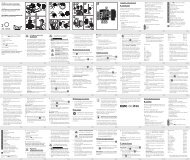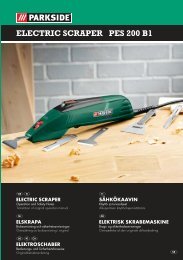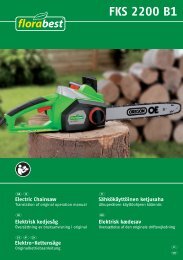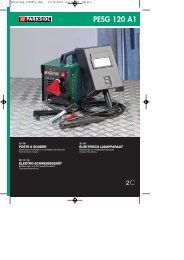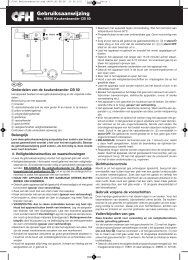20x-1280x - Lidl Service Website
20x-1280x - Lidl Service Website
20x-1280x - Lidl Service Website
Create successful ePaper yourself
Turn your PDF publications into a flip-book with our unique Google optimized e-Paper software.
we make it by means of a pre-treatment or penetration with suitable<br />
materials (media) transparent or thus that we cut finest wafers off of<br />
them (hand cut, MicroCut) and these then examine. With these<br />
methods will us the following part make familiar.<br />
7.2 Manufacture of thin preparation cuts<br />
Specimens should be sliced as thin as possible, as stated before. A<br />
little wax or paraffin is needed to achieve the best results. A candle<br />
can be used for the purpose. The wax is put in a bowl and heated over<br />
a flame. The specimen is then dipped several times in the liquid wax.<br />
The wax is finally allowed to harden. Use a MicroCut (Fig 6, 24) or<br />
knife/scalpel (carefully) to make very thin slices of the object in its wax<br />
casing. These slices are then laid on a glass slide and covered with<br />
another.<br />
7.3 Manufacture of an own preparation<br />
Put the object which shall be observed on a glass slide and give with<br />
a pipette a drop of distilled water on the object (Fig. 7).<br />
Set a cover glass (in each well sorted hobby shop available) perpendicularly<br />
at the edge of the water drop, so that the water runs along<br />
the cover glass edge (Fig. 8). Lower now the cover glass slowly over<br />
the water drop.<br />
Note.<br />
The gum medium supplied (Fig 6, 25b) is used to make<br />
permanent slide cultures. Add it instead of distilled water. The<br />
gum medium hardens so that the specimen is permanently affixed<br />
to its slide.<br />
8. Experiments<br />
If you made yourself familiar with the microscope already, you can<br />
accomplish the following experiments and observe the results under<br />
your microscope.<br />
8.1 Newspaper print<br />
Objects:<br />
1. A small piece of paper from a newspaper with parts of a picture and<br />
some letters<br />
2. A similar piece of paper from an illustrated magazine<br />
Use your microscope at the lowest magnification and use the<br />
preparation of the daily paper. The letters seen are broken out, because<br />
the newspaper is printed on raw, inferior paper. Letters of the magazines<br />
appear smoother and more complete. The picture of the daily paper<br />
consists of many small points, which appear somewhat dirty. The pixels<br />
(raster points) of the magazine appear sharply.<br />
8.2 Textile fibers<br />
Items and accessories:<br />
1. Threads of different textiles: Cotton, line, wool, silk, Celanese,<br />
nylon etc..<br />
2. Two needles<br />
Each thread is put on a glass slide and frayed with the help of the two<br />
needles. The threads are dampened and covered with a cover glass.<br />
The microscope is adjusted to a low magnification. Cotton staples are<br />
of vegetable origin and look under the microscope like a flat, turned<br />
volume. The fibres are thicker and rounder at the edges than in the<br />
centre. Cotton staples consist primary of long, collapsed tubes. Linen<br />
fibres are also vegetable origin; they are round and run in straight lines<br />
direction. The fibres shine like silk and exhibit countless swelling at the<br />
fibre pipe. Silk is animal origin and consists of solid fibres of smaller<br />
diameter contrary to the hollow vegetable fibres. Each fibre is smooth<br />
and even moderate and has the appearance of a small glass rod.<br />
Wool fibres are also animal origin; the surface consists of overlapping<br />
cases, which appear broken and wavy. If it is possible, compare wool<br />
fibres of different weaving mills. Consider thereby the different appearance<br />
of the fibres. Experts can determine from it the country of origin<br />
of wool. Celanese is like already the name says, artificially manufactured<br />
by a long chemical process. All fibres show hard, dark lines on the<br />
smooth, shining surface. The fibres ripple themselves/crinkle after drying<br />
in the same condition. Observe the thing in common and differences.<br />
8.3 How does bread mushroom develop?<br />
Object: An old piece of bread<br />
The spores of the kind of mushroom, which strike our bread, are to be<br />
found everywhere in the atmosphere. Put bread on a slide and squirt<br />
carefully some water on it. Moisten bread only, don’t wet it. Put the<br />
whole into a container with a screw-type cap and to place it into a<br />
cabinet, into which only little light breaks in and prevails it in a warm<br />
temperature. Within a short time the black bread mushroom forms.<br />
Regard the bread each day. At the first the mould shows up a white,<br />
shining consistence. Take it on a slide to observe it. The material turns<br />
out as a complicated thread mass, which forms the mushroom body<br />
- 5 -<br />
in its whole. One calls the whole Mycelium. Each thread is a Hyphe.<br />
Soon some Rhizoids arise, which embody the mould fungus with<br />
bread, in order thereby to water and nutrients for the growth of the<br />
Mycelium to receive. In the course of time the Rhizoid colours itself<br />
brownish. Vertically over this group Hyphen grow like long slim stakks,<br />
which end in a tiny small, white ball. One calls the stack<br />
Sporangiophores (carrier of the Sporcap), the ball is a Sporangium or<br />
a Sporcapl. Soon these balls accept a black color. Inside sporen present<br />
mature. If now the Sporcap breaks open, then it sets the spors<br />
free, which step now to air and infect other bread. With the naked eye<br />
you can mature the Sporcaps as tiny black marks to recognize. They<br />
are scattered on the mould fungus surface and give thus to the kind of<br />
mushroom its name. There are however still different kinds of mould<br />
fungi. They can be pink, red, blue or green. Manufacture yourselves<br />
preparations of all stages of the bread mould.<br />
8.4 Salt water prawns<br />
Accessories:<br />
1. Prawn eggs (Fig 6, 25d)<br />
2. Sea salt (Fig 6, 25c)<br />
3. Prawn breeding plant (Fig 6, 23)<br />
4. Yeast (Fig 6, 25a)<br />
8.4.1 The lifecycle of the saltwater prawn<br />
The saltwater prawn or artimia salina to scientists has an unusual and<br />
interesting lifecycle. The female's eggs are hatched without any male<br />
shrimp having to fertilise them. The resultant baby prawns are all<br />
female. Under unusual circumstances such as when a swamp is drained<br />
the eggs may produce male prawns. These males fertilise the<br />
female's eggs, resulting in a specific type of eggs. These are called<br />
winter eggs and have a thick shell as protection. They’re pretty rugged<br />
and can survive the swamp or lake drying out causing the death of the<br />
entire prawn population for up to a decade in a form of hibernation.<br />
The eggs hatch once the right ambient conditions again obtain. The<br />
eggs supplied (Fig 6, 25d) are of this type.<br />
8.4.2 Hatching of the salt water prawn<br />
To hatch the prawn it is essential to first have a saline solution suited<br />
to the prawn's needs. Fill half a litre of rain- or fresh-water in a container.<br />
Let it stand for about thirty hours. As water evaporates over time<br />
it's a good idea to have a second container of such water left standing<br />
for thirty-six hours. Once it's stood for this length of time pour half of<br />
the sea salt supplied into one of the containers (Fig 6, 25c) and stir<br />
until it has dissolved. Then pour some of it into the prawn breeding<br />
plant (Fig 6, 23). Add a few eggs and close the lid. Put it somewhere<br />
with plenty of light but not in the direct sun. The temperature should<br />
be approximately 25 C. The prawns will hatch in two or three days at<br />
this temperature. Should any water evaporate during this time replace<br />
it from the second container.<br />
8.4.3 The saltwater prawn under the microscope<br />
What comes out of the egg is known as a nauplius larva. Use the<br />
pipette (Fig 6, 22b) to put some of them on a slide for examination.<br />
They will move in the solution using their hair like limbs. Remove a few<br />
daily from the container for examination under the microscope. If you<br />
do so and save the pictures made with the MicrOcular you will then<br />
have a seamless record of the prawn's lifecycle. You can remove the<br />
upper lid of the prawn bleeding plant and put the whole thing under<br />
the microscope. The larvae will mature in six to ten weeks depending<br />
on ambient temperature. You will soon have bred an entire generation<br />
of saltwater prawns that constantly reproduce.<br />
8.4.4 Feeding your saltwater prawns<br />
To keep them alive saltwater prawns must be fed occasionally. This<br />
must be done carefully as overfeeding causes the water to stagnate<br />
and poison the prawns. Feeding is best down with dry powdered<br />
yeast (Fig 6, 25a). Give them a little every other day. If the water darkens<br />
this signifies it is stagnating. If so remove the prawns and put<br />
them in a fresh saline solution.<br />
Note.<br />
Eggs and prawns are not fit for human consumption.<br />
GB<br />
IE<br />
NL<br />
BE<br />
HU<br />
PL<br />
SI<br />
DE<br />
AT<br />
CH<br />
BE





